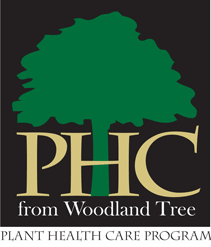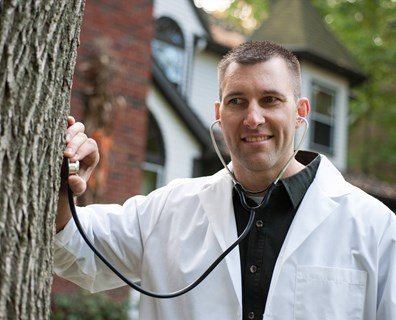Why Plant Health Care?
 The most common reason tree owners
call us is concern that something is wrong with their tree. Well, that’s really the motivation to call us in the first place. We hear it all the time: “What is that bug?” “ “Why are there
holes in my azalea leaves?” “I love my sweetgum, but I hate the gumballs.” “My tree looks sick.” “The bark on my tree is coming off.” Other issues may be that some
of the leaves are discolored, a branch has died, or perhaps the entire tree has been dropping leaves when it is “not supposed to”. Sometimes the cause of concern is a minor problem that is easily explained
and corrected. Other times the problem is more complex—with several underlying causes and a remedy that requires treatments extending over several years. Unfortunately, there are instances in which the problem
has gone undetected for so long that the tree cannot be helped, and the only option is removal. If an arborist had been called earlier, perhaps the tree could have been saved.
The most common reason tree owners
call us is concern that something is wrong with their tree. Well, that’s really the motivation to call us in the first place. We hear it all the time: “What is that bug?” “ “Why are there
holes in my azalea leaves?” “I love my sweetgum, but I hate the gumballs.” “My tree looks sick.” “The bark on my tree is coming off.” Other issues may be that some
of the leaves are discolored, a branch has died, or perhaps the entire tree has been dropping leaves when it is “not supposed to”. Sometimes the cause of concern is a minor problem that is easily explained
and corrected. Other times the problem is more complex—with several underlying causes and a remedy that requires treatments extending over several years. Unfortunately, there are instances in which the problem
has gone undetected for so long that the tree cannot be helped, and the only option is removal. If an arborist had been called earlier, perhaps the tree could have been saved.
The Solution: Plant Health Care
 Situations such as these led us to create Plant Health Care (PHC) programs. The
objective of PHC is to maintain or improve the landscape’s appearance, vitality and—in the case of trees—safety, using the most cost-effective and environmentally sensitive practices and treatments
available. Plant Health Care involves monitoring, using preventive treatments, and adopting a strong commitment to working closely with you, the tree owner.
Situations such as these led us to create Plant Health Care (PHC) programs. The
objective of PHC is to maintain or improve the landscape’s appearance, vitality and—in the case of trees—safety, using the most cost-effective and environmentally sensitive practices and treatments
available. Plant Health Care involves monitoring, using preventive treatments, and adopting a strong commitment to working closely with you, the tree owner.
Why Plant Health Care, Not Tree Health Care
While trees are dominant ornamental features in your home landscape, they share this area with turfgrasses, shrubs, and bedding plants. And all these plants have one resource in common: the soil. The roots of trees, shrubs,
turfgrass, and bedding plants intermingle and compete for water and nutrients. In fact, the roots of a single mature tree may extend 60 feet or more out into your lawn or flower beds. Every treatment applied to the
lawn (fertilizer and herbicide, for example) can impact the appearance and vitality of a tree. Conversely, treatments applied to a tree, such as pruning and fertilizing, can influence the appearance and vitality of
the underlying turfgrass. The care of each plant in a landscape can affect the health of every plant in that landscape.
Why Contact an Arborist for Plant Health Care?
 Trees and shrubs represent a considerable long-term investment in your
landscape. With proper care, these plants can provide beautiful surroundings, cooling shade, and many other benefits for decades. We have the experience and training to detect many potential tree and shrub problems
before they become life threatening or hazardous. In addition, arborists can make tree and shrub recommendations, such as species selection and placement, to keep many problems from occurring in the first place. We
can also consult with other landscape services you may use, lawn care for example, to ensure that the treatments are coordinated and will not be harmful to your trees and shrubs. Remember, the potential size and longevity
of trees and shrubs warrants their special attention in your landscape. Bedding plants can be replaced in a few short weeks and a lawn in a single growing season, but it can take a lifetime or more to replace a mature
tree.
Trees and shrubs represent a considerable long-term investment in your
landscape. With proper care, these plants can provide beautiful surroundings, cooling shade, and many other benefits for decades. We have the experience and training to detect many potential tree and shrub problems
before they become life threatening or hazardous. In addition, arborists can make tree and shrub recommendations, such as species selection and placement, to keep many problems from occurring in the first place. We
can also consult with other landscape services you may use, lawn care for example, to ensure that the treatments are coordinated and will not be harmful to your trees and shrubs. Remember, the potential size and longevity
of trees and shrubs warrants their special attention in your landscape. Bedding plants can be replaced in a few short weeks and a lawn in a single growing season, but it can take a lifetime or more to replace a mature
tree.
What Does a Tree and Shrub PHC Program Cover?
Every home landscape is unique, so there is no standard PHC program. Plant Health Care programs do have features in common, however.
- First, PHC involves monitoring tree and shrub health. This step allows problems to be detected and managed before they become serious. The monitoring may be as simple as annual visits to check on a few special trees
in your landscape, or it may involve more frequent quarterly or monthly inspections of all your trees and shrubs. The monitoring frequency and complexity of your PHC program depends on the size and diversity of
your landscape as well as your particular landscape goals.
- Second, if problems or potential problems are detected or anticipated during a monitoring visit, your arborist will develop solutions. The solution could be a simple change in your lawn irrigation schedule—many
trees are kept too moist—or more detailed suggestions, such as pruning or spot applications of pesticides.
- Finally, PHC involves you, the client. Your Arborist PHC Specialist will give you information about your trees and shrubs. This information ensures that decisions are made that address your concerns and are appropriate
to your landscape budget and goals. Information may be provided through a variety of means. Obviously, discussions and answering questions are important means of conveying information, but many PHC programs include
written recommendations after each monitoring visit. Plant Health Care is a program tailored to the needs of the client and his or her trees and shrubs.
How Will My Trees and Shrubs Benefit from PHC?
Because ornamental trees and shrubs can quickly succumb to problems, routine monitoring and timely treatments can protect your landscape investment and reduce expenses. A monitoring visit to your landscape might reveal
- a hidden infestation of tent caterpillars that may soon defoliate the ornamental crabapples in your front yard
- a weakly attached branch that may fall and damage the house
- solutions for all those gumballs from your sweetgum tree
- improperly pruned shrubs that are not flowering as abundantly as they should.
Your Arborist PHC Specialist can recommend treatments and changes in maintenance practices that can eliminate these problems while maximizing the safety and aesthetic quality of your landscape.
What Will a PHC Program Cost?
Because each program is individually designed to fit the needs of a particular landscape, no standard price can be given without a site visit and assessment. You may have an interest in developing a plan for a few key trees
in your landscape, or you may wish to have the entire landscape placed on a program. PHC programs can also be structured in different ways. For example, some programs charge a fee for monitoring and bill each treatment
separately. Other programs have an annual fee that covers all monitoring visits for the season as well as many potential treatments. These more comprehensive programs provide the peace of mind in knowing that treatments
for most potential problems are already covered by the program without additional charges. Individualized programs and flexibility are at the heart of PHC. You will find that your arborist can design a Plant Health
Care program that fits your goals and budget.
As always, we want to help you enjoy your trees and shrubs for as long as possible and adding a proactive Plant Health Care plan is another great step to extending their benefits for years to come.